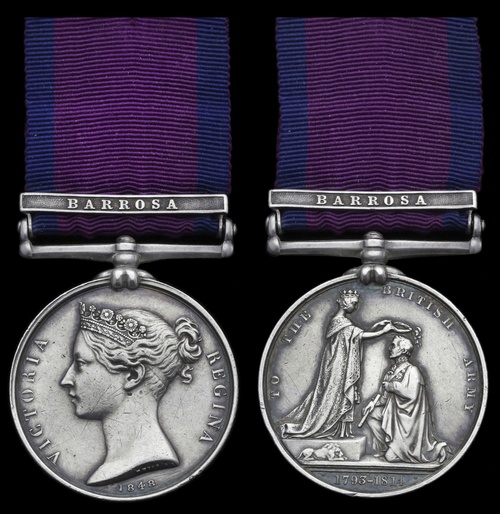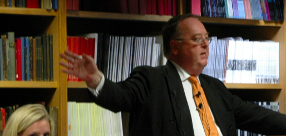
Auction: 20002 - Orders, Decorations, Medals & Space Exploration
Lot: 259
THE BATTLE OF BARROSA (Cerro de Puerco); 5 March 1811
After a long overnight march the Cavalry made the heights of Barrosa on the morning of 5 March without meeting any enemy, nor did the flanks covering the east flank, the west being bounded by the sea. General Graham was ordered by the Spanish Commander La Pena to halt on the south east slope of the heights, some four miles south of the Santi-Petri River.
The landscape around the height extended inland to the plains of Chiclana, being skirted by a pine forest extending north to Santi-Petri, the land being very uneven and broken.
During the morning the Spanish commanded by General Zayas crossed the Santi-Petri by pontoon bridge from the Isle de Leon attacking the French vanguard. General La Pena instructed General Graham to move down the heights northwards to the Torre de Bermeja and secure communications with General Zayas.
Graham wanted to hold the strategic position on the hill at Barrosa preventing any French attack from trapping the allied army in the headland between the sea and salt flats. He however reluctantly acquiesced to La Pena, being conditional that La Pena would stay and protect the hill, a task he failed to carry out moving shortly after to Santi-Petri leaving the hill protected by Spanish Cavalry commanded by General Whittingham, supported by two Spanish Brigades and Artillery, plus the baggage guard comprising Flank Companies of the 2/9th 1/28th 1/82nd commanded by Lieutenant-Colonel Browne, 28th Foot.
At about noon Graham's Division marched through the woods towards Bermeja. Whilst on the move, he received information that the French had appeared in force on the plain and were also marching towards the heights at Barrosa. Upon seeing the enemy the Spanish rapidly descended to the west leaving Lieutenant-Colonel Browne with his Flank Company's to defend the heights.
When asked by Colonel Whittingham commanding the cavalry what his intentions were he replied:
'I intend to fight the French'
At which Whittingham retreated with Browne's words ringing in his ears:
'I shall stop where I am, for it shall never be said that John Frederick Browne ran away from the post which his General ordered him to defend.'
At this the Spanish turned and marched away to the shouts and taunts of the British which now consisted 470 Bayonets and 'El Commandante Loco' Browne. Realising the danger they withdrew in Columns of quarter distance downhill to the pine wood toward Bermeja. The French cavalry soon surrounded the columns; herding them in, fearing the artillery would soon appear Browne did not form square for the French artillery to fire grape shot at them.
Ruffin now held the hill with 1/9th Leger, 1/96th Ligne, 1 & 2/24th Ligne, with two provisional battalions of Grenadiers, supported by artillery and cavalry
While this had been occurring General Graham had been informed that the French were on the hill and at his rear. Quickly ordering a counter-march he rode back to the hill and seeing Browne asked why he had left the hill, to which he replied:
'But you would not have me fight the whole French army with 470 men.'
When the situation of the Spanish having fled was explained to General Graham, he told Browne to instantly turn and attack in open order. The flank Battalion was put in skirmishing order, when the General returned and told them to attack in compact Battalion.
The Bugler sounded close on centre, Colonel Browne rode to the front of the column raised his hat and shouted:
'Gentlemen, I am happy to be the bearer of good news: General Graham has done you the honour of being the first to attack those fellows. "Now follow me you rascals!"'
So with 470 men and 21 Officers as sacrificial lambs they advanced buying time for the Guards to appear and form line the attack commenced. As soon as they crossed the ravine and closed up, the French line opened a murderous fire of musket and grape-shot from the eight artillery pieces, mowing down over half the officers and men. They assembled a second line, again the French fired knocking over a further fifty men.
Sensibly the remaining men refused to reform a third time and sought cover behind trees, lying down on the uneven ground from where they returned sporadic fire. The French did not advance to finish the remains off as Brigadier-General Dilkes with his brigade of Guards emerged from the woods with the Rifles on the right flank.
Meanwhile Major Duncan with ten guns taking up a centre position opened fire supported by an ammunition guard of 2/47th. His Despatch takes up the action:
'The whole of our Brigades amounting to ten pieces were marching together in column near the front of the Troops; they immediately counter-marched with the rest and got out of the wood with all speed. As soon as we cleared it the Enemy were seen to be within 1100 yards, and deploying into line on an advantageous position, whilst ours could scarcely have been worse being much confined, low, and in the midst of high Furze; such was the General's anxiety for the Artillery to get into action that we did so before our Troops were up, so that for more than 20 minutes while our Light Corps engaged the Enemys on their right Flank the ten guns (formed together in line) carried on a most destructive fire against their centre and left Flank.
The ground admitted of no manœuvering so that the action very quickly became general and I believe a warmer one never took place. Our guns were much exposed to the Enemy's Light Troops and were, besides, enfiladed from the beginning by their Artillery on our Right Flank.
After an exceedingly hot fire for about an hour the General brought up his Second Line, formed closer action and presently charged both forward and to our left Flank where the Enemy had pushed round a considerable force; this ended the day without the assistance (I may almost say) of a single Spaniard out of their 7000!'
On the right flank, Norcott was in command of the 2/95th who formed the rear-guard and hearing from the German Hussars, moved his column and left the wood, entering the clearing to see the enemy.
The Guards had to cross a deep hollow, under a severe fire, before they could close with the enemy; they came up in loose skirmishing order, but in 'fighting mood' and without stopping to reform rushed up the hill to face Ruffin's advancing battalions 1 & 2/24th Ligne. History tells us that the fresh Frenchmen attacking downhill should easily have been able to break through the ragged enemy they faced. It wasn't to be.
Dilke had 1,400 bayonets against the French, the two columns of 24th Ligne advancing with drums beating and bayonets levelled advancing on the ragged centre occupied by the 1st Foot Guards were checked by a furious fire from the semi-circle into which they pushed to advance.
Regardless that the men had marched two miles and climbed two hundred feet, lost their order, been under fire and themselves firing uphill; their fire was delivered with outstanding accuracy, by the veteran soldiers, the whole head of the advancing columns were blown to pieces bringing the advance to a halt, opening irregular fire against the British.
Ruffin on the top of the hill then ordered the Grenadiers with General Chaudron Rouseau leading to attack the British right against the 3rd Foot Guards and 2/67th.
The French Grenadiers managed to be just a few steps from Dilkes line, when they halted and a murderous fire was exchanged by both sides with the British line and superior musketry fire forcing them to retreat
On the left flank, the first to emerge from the wood onto the plain of Chiclana to face Lavall's right wing, were Barnard's 3/95th and Bushe's 20th Potuguese Cacadores forming in skirmishing order attacking the flanks of the advancing French columns. This sudden and unexpected attack by the skirmishers caused alarm in the French ranks, who fearing a cavalry attack, formed square. This gained time for the Artillery to charge from the wood and discharge the into the square.
Facing them was an uneven line of four French Battalion Columns - the British deployed two Columns in line, with the French advancing by drums accompanied by a chorus of "Vive L'Empereur". Their centre column fired by volley, whilst the left and right used independent fire. A volley was fired by the British, before the order was given to charge with bayonets.
The 2/87th charged screaming "Faugh A Ballagh" (Clear the way). Supported by the Coldstream Guards. The French held column until the charging British were within twenty-five yards when they tried to turn and escape, but being in column they were unable to pass through their own ranks. As the 87th smashed their way through the ranks they set sights on the Eagle presented to the 1/8th Regiment by Napoleon himself.
The first man to capture the Eagle was Ensign Keogh, who was quickly cut down by the French. Sergeant Masterton, then took it up and secured it, with it later being paraded and presented to the Prince Regent.
Having routed the 1/8th Ligne, Gough managed to form half his scattered troops against the 45th Ligne held in Reserve. They got to within 50 yards before the enemy fled upon opening fire.
The 67th, when the 87th and 2nd Guards attacked, moved along the flank and rear of the 2/8th Ligne pouring musket fire into their ranks, pushing them against the 1/8th Ligne.
Lieutenant-Colonel Belson of the 28th, were the main unit of the celebrated "Slashers" on the left of Wheatley's Brigade. They moved up without firing a shot, advancing to deal with the French 54th Regiment on the right, an officer of the Battalion described the events:
'The Colonel then gave orders to fire by platoons from centre to flanks, and aim low "Fire at their legs and spoil their dancing". This was kept up for a short time with dreadful effect. The action being now general all along the line we twice attempted to charge. But the enemy being twice our strength (some of our flank companies being away (Under Lieutenant-Colonel Browne)), only retired a little on each occasion. Finally giving three cheers, we charged a third time and succeeded: the enemy now gave way and fled in every direction.'
At the close of play, the tactical Allied victory had cost some 1,500 killed or wounded.
The Military General Service Medal awarded to Lieutenant R. L. Haydon, 28th Foot, who was severely wounded in the thigh at New Orleans in 1815 with the 44th Foot
Military General Service 1793-1814, 1 clasp, Barrosa (Robt. Haydon, Ensn. 28th Foot.), light contact marks, very fine
Provenance:
Sotheby, Wilkinson & Hodge, July 1897.
Biddle & Webb, December 2008.
Robert Luscombe Haydon was born in June 1794 at Crediton, Devon, he was apprenticed as a haberdasher to Mr. Frith of Pope & Frith Hosiers, 28 Friday Street, London. On 29 May 1809 he purchased an Ensigncy to 2nd Battalion, 28th Foot and would in November 1811 be in the Peninsula. By April 1812 he was at Gibraltar with the 1st Battalion on garrison duty and may have served on detachment with Lieutenant-Colonel Browne at Tarifa, being involved on the attack of Medina Sidonia.
The 28th at Tarifa would form part of Lieutenant-General Graham's detachment with the Light & Grenadier Company's with Browne, whilst the remainder under Lieutenant-Colonel Belson would be formed under Wheatley's Brigade. On 5 March it is more than possible that Haydon was in Belson's command formed on the extreme left of Wheatley's Brigade against the French 54th Ligne. Following Barrosa he was promoted Lieutenant viz Little who was killed in action.
The Battalion were moved from Gibraltar to Wellington's Command in the advance from Portugal to Spain and on 3 January 1813 Haydon resigned his commission to return to England. Just over a year later on 24 February 1814 he purchased an Ensigncy in the 44th Foot who were serving at Tarragona in north-east Spain, moving to the south of France on the defeat of Napoleon. From here they were ordered to sail for America and join the troops fighting in that theatre. On 10 September 1814, Haydon sailed from Portsmouth on Dover and Hydra with reinforcements. By 8 January 1815 arrangements were made for a force to attack New Orleans - when his unit was mauled and in which Haydon was severely wounded in the thigh. So damaging was the action that a Court Martial was called against Lieutenant-Colonel Mullins for the disobedience of orders which led to such significant casualties. Transferred to the 20th Foot on half-pay on 1 May 1819, Haydon moved to Letterkenny, Donegal, Ireland were he married. He made an application as a Revenue Officer and as a Chief Constable and wrote to the Chief Secretary at Dublin Castle in 1825 complaining how his half-pay was not sufficient (National Irish Archives CSO/RP/1825/1126, refer). He became a widower in 1851 and died on 25 November 1865.
Subject to 20% VAT on Buyer’s Premium. For more information please view Terms and Conditions for Buyers.
Sold for
£5,800
Starting price
£1600




